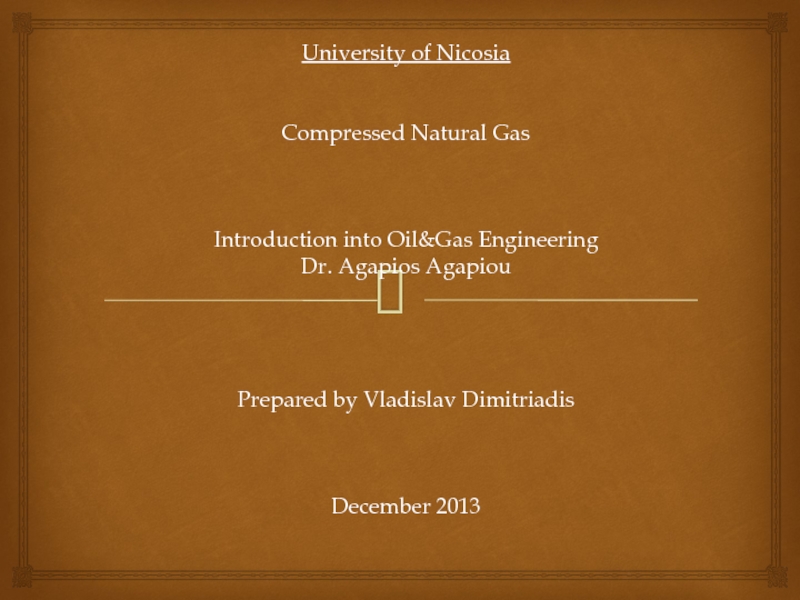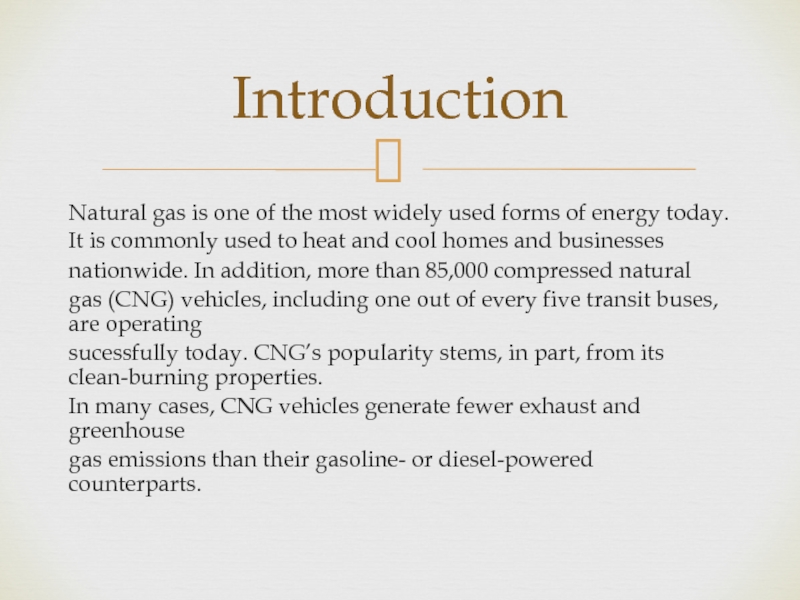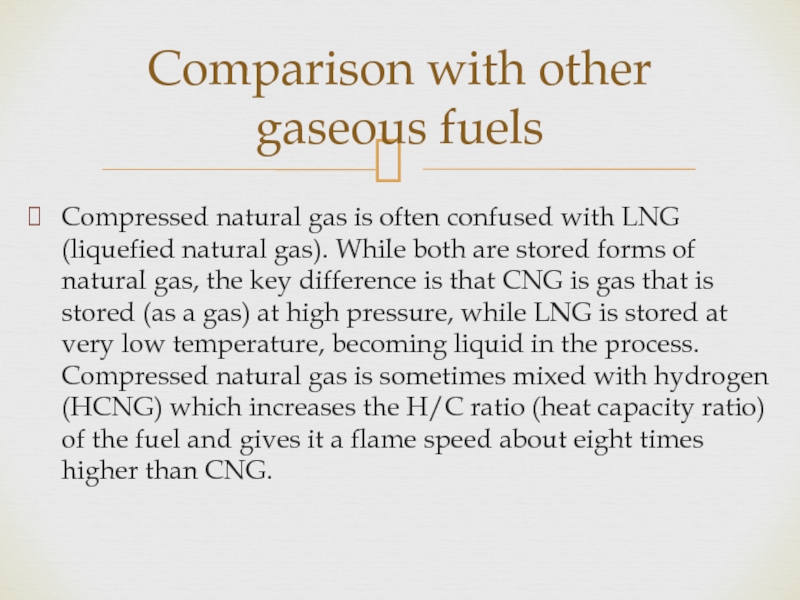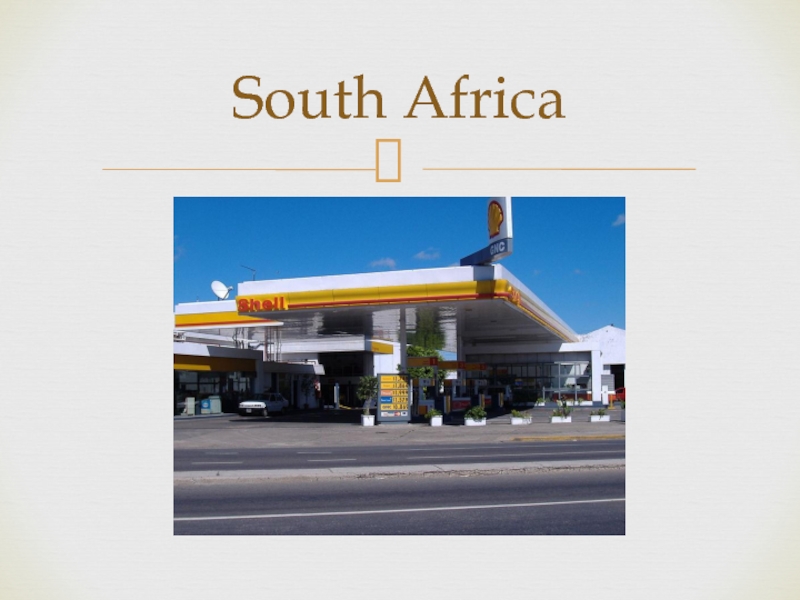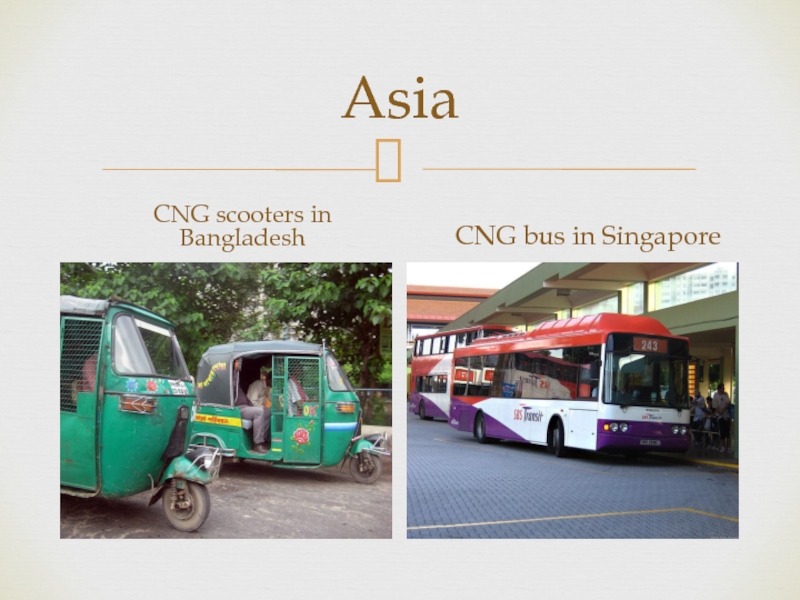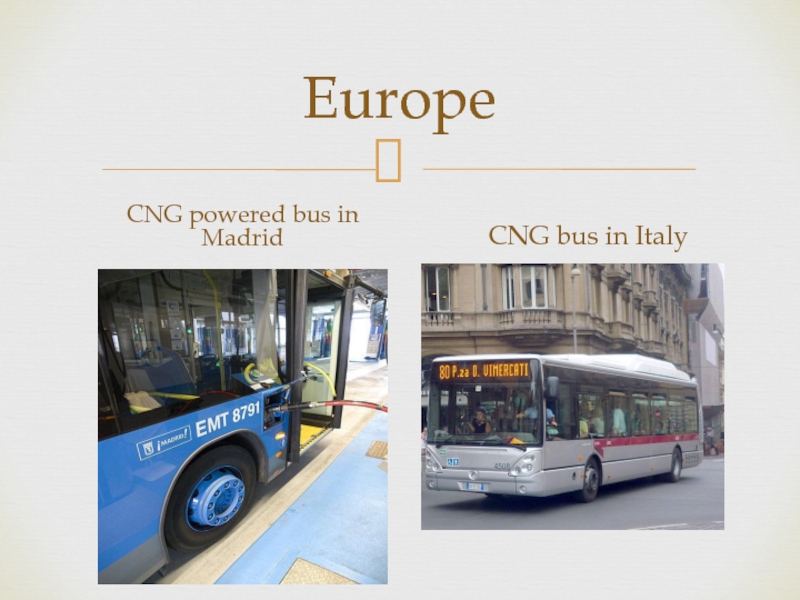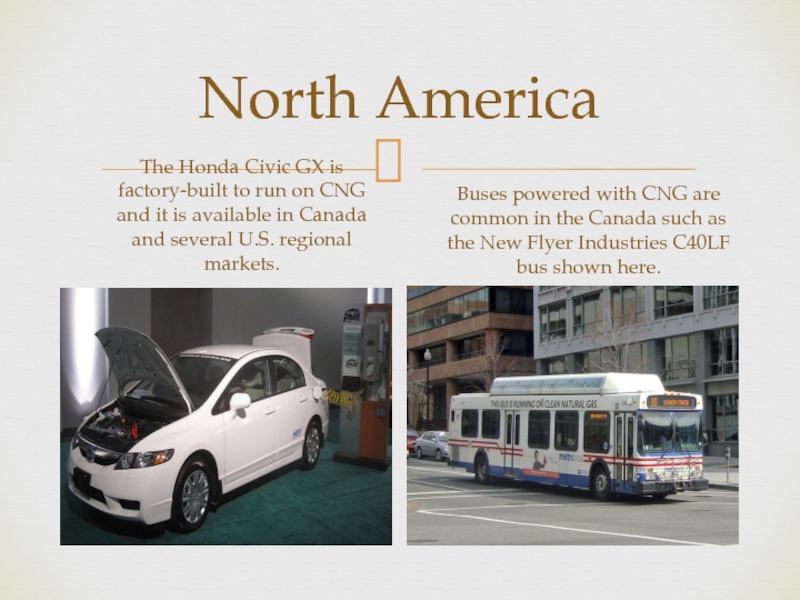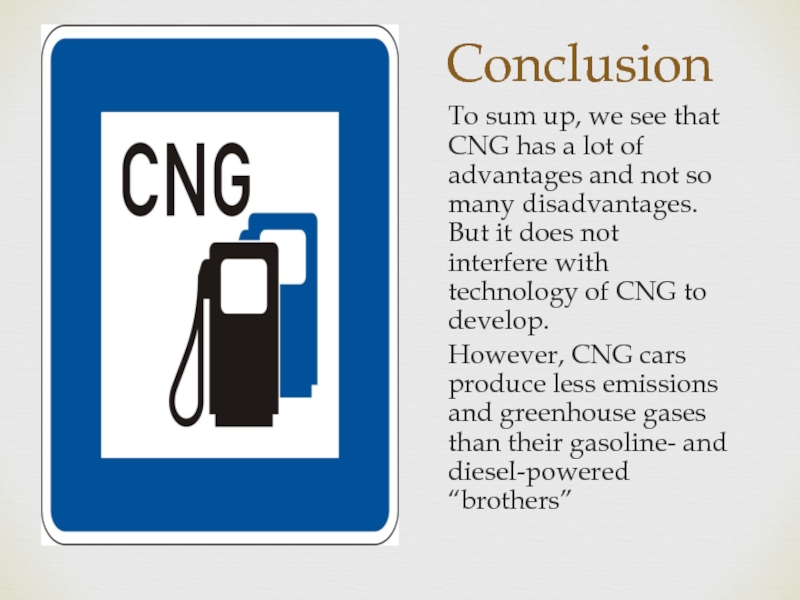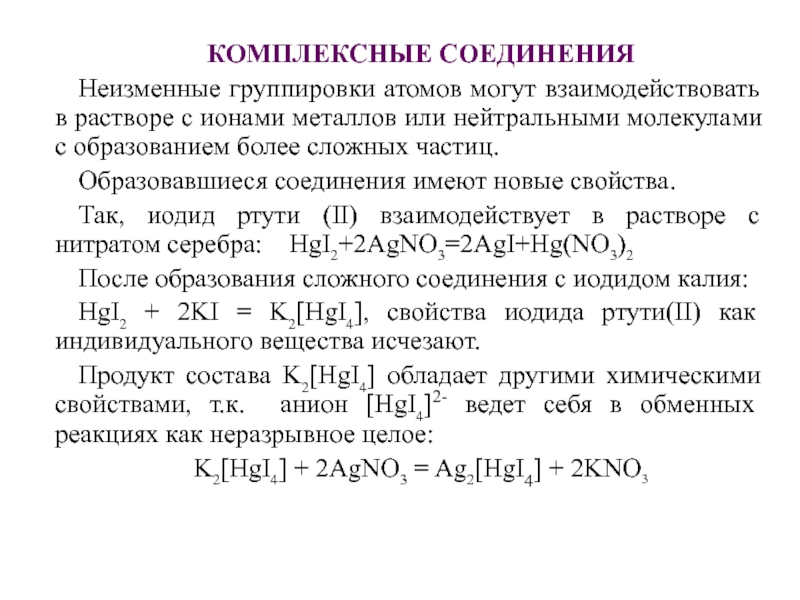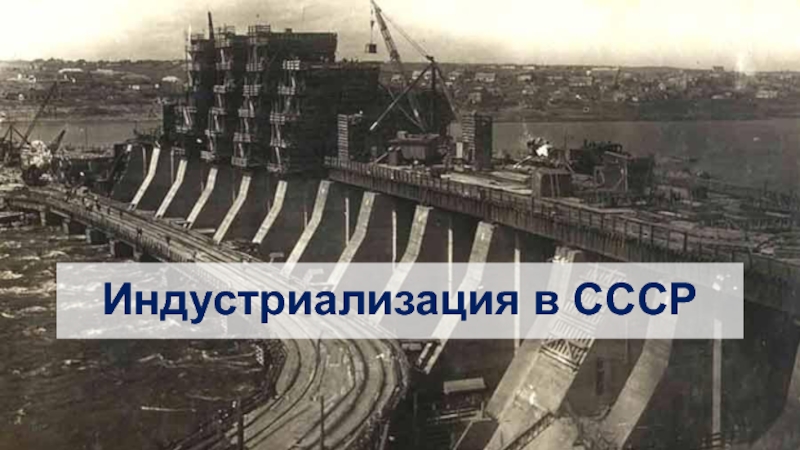Разделы презентаций
- Разное
- Английский язык
- Астрономия
- Алгебра
- Биология
- География
- Геометрия
- Детские презентации
- Информатика
- История
- Литература
- Математика
- Медицина
- Менеджмент
- Музыка
- МХК
- Немецкий язык
- ОБЖ
- Обществознание
- Окружающий мир
- Педагогика
- Русский язык
- Технология
- Физика
- Философия
- Химия
- Шаблоны, картинки для презентаций
- Экология
- Экономика
- Юриспруденция
University of Nicosia Compressed Natural Gas Introduction into Oil&Gas
Содержание
- 1. University of Nicosia Compressed Natural Gas Introduction into Oil&Gas
- 2. Natural gas is one of the most
- 3. What Is CNG? CNG is methane stored
- 4. How we use it ?In CarsIn Locomotives
- 5. CNG does not contain any lead, thereby
- 6. Compressed natural gas vehicles require a greater
- 7. Compressed natural gas is often confused with
- 8. Worldwide uses
- 9. South Africa
- 10. AsiaCNG scooters in BangladeshCNG bus in Singapore
- 11. EuropeCNG powered bus in MadridCNG bus in Italy
- 12. North AmericaThe Honda Civic GX is factory-built to run
- 13. OceainaK230UB CNG bus currently used as part
- 14. ConclusionTo sum up, we see that CNG
- 15. Скачать презентанцию
Natural gas is one of the most widely used forms of energy today.It is commonly used to heat and cool homes and businessesnationwide. In addition, more than 85,000 compressed naturalgas (CNG)
Слайды и текст этой презентации
Слайд 1University of Nicosia Compressed Natural Gas Introduction into Oil&Gas Engineering Dr. Agapios Agapiou Prepared
by Vladislav Dimitriadis
December 2013
Слайд 2Natural gas is one of the most widely used forms
of energy today.
It is commonly used to heat and cool
homes and businessesnationwide. In addition, more than 85,000 compressed natural
gas (CNG) vehicles, including one out of every five transit buses, are operating
sucessfully today. CNG’s popularity stems, in part, from its clean-burning properties.
In many cases, CNG vehicles generate fewer exhaust and greenhouse
gas emissions than their gasoline- or diesel-powered counterparts.
Introduction
Слайд 3What Is CNG?
CNG is methane stored at high pressures.
CNG is made by compressing natural gas (which is mainly
composed of methane, CH4), to less than 1 percent of the volume it occupies at standard atmospheric pressure. It is stored and distributed in hard containers at a pressure of 200–248 bar (2,900–3,600 psi), usually in cylindrical or spherical shapes.CNG is odorless, colorless, and tasteless. It consists mostly of methane and is drawn from gas wells or in conjunction with crude oil production. CNG vehicles store natural gas in high-pressure fuel cylinders at 3,000 to 3,600 pounds per square inch. An odorant is normally
added to CNG for safety reasons.
Слайд 5CNG does not contain any lead, thereby eliminating fouling of
spark plugs.
CNG-powered vehicles have lower maintenance costs than other hydrocarbon-fuel-powered
vehicles.CNG fuel systems are sealed, preventing fuel losses from spills or evaporation.
Increased life of lubricating oils, as CNG does not contaminate and dilute the crankcase oil.
Being a gaseous fuel, CNG mixes easily and evenly in air.
CNG is less likely to ignite on hot surfaces, since it has a high auto-ignition temperature (540 °C), and a narrow range (5–15 percent) of flammability.
Advantages
Слайд 6Compressed natural gas vehicles require a greater amount of space
for fuel storage than conventional gasoline powered vehicles. Since it
is a compressed gas, rather than a liquid like gasoline, CNG takes up more space for each GGE (gasoline gallon equivalent). Therefore, the tanks used to store the CNG usually take up additional space in the trunk of a car or bed of a pickup truck which runs on CNG. This problem is solved in factory-built CNG vehicles that install the tanks under the body of the vehicle, leaving the trunk free (e.g., Fiat Multipla, New Fiat Panda, Volkswagen Touran Ecofuel, Volkswagen Caddy Ecofuel, Chevy Taxi - which sold in countries such as Peru). Another option is installation on roof (typical on buses), requiring, however, solution of structural strength issues.Drawbacks
Слайд 7Compressed natural gas is often confused with LNG (liquefied natural
gas). While both are stored forms of natural gas, the
key difference is that CNG is gas that is stored (as a gas) at high pressure, while LNG is stored at very low temperature, becoming liquid in the process. Compressed natural gas is sometimes mixed with hydrogen (HCNG) which increases the H/C ratio (heat capacity ratio) of the fuel and gives it a flame speed about eight times higher than CNG.Comparison with other gaseous fuels
Слайд 12North America
The Honda Civic GX is factory-built to run on CNG and
it is available in Canada and several U.S. regional markets.
Buses powered
with CNG are common in the Canada such as the New Flyer Industries C40LF bus shown here.Слайд 13Oceaina
K230UB CNG bus currently used as part of the "Scania
Koala CNG Bus Trial" at ACTION in Canberra.
A Mercedes-Benz OC500LE (withCustom Coaches bodywork)
running on CNG, operated by Sydney Buses in Sydney, Australia.Слайд 14Conclusion
To sum up, we see that CNG has a lot
of advantages and not so many disadvantages. But it does
not interfere with technology of CNG to develop.However, CNG cars produce less emissions and greenhouse gases than their gasoline- and diesel-powered “brothers”
